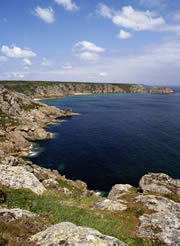A theory explains the fractal structure of the shoreline
Philip Ball, Nature (translation: Dikla Oren)

Direct link to this page: https://www.hayadan.org.il/coastfract.html
The beauty of the jagged coastal strips will be preserved, no matter how much the sea batters them. The classic beach look is a balance between the weathering power of the sea and the beach's ability to reduce it, say researchers from France and Italy.
Although the beach crumbles and breaks under the determined onslaught of the waves, it soon takes on the scarred shape of a fractal, changing the force that causes weathering. "Regardless of its initial shape, a rocky beach will eventually become a fractal," the researchers concluded.
When the science of fractals began to emerge in the 1960s, the complex arrangement of beaches made them the best example of a fractal in nature. A fractal pattern repeats itself many times at different levels of magnification - so that a mile-long stretch of beach looks as jagged as a hundred-mile stretch of beach.
But no explanation has ever been provided for the coastlines being fractal, says Bernard Spobel of the Polytechnic College of Palisio, France.
That is, no explanation has ever been provided until now. "Fractal coastlines excel at breaking waves," Spobel explains. "When the beach softens the impact of the waves, it reduces the weathering it is subjected to."
To test the idea, Spovel and his colleagues built a computer model of beach erosion. The material in the model is removed from the beach by the rapid "quarrying" of waves or by the slow effect of the weather, when minerals dissolve in the water.
The beach in the model is divided into a grid. The rocky type, resistant to weather erosion, varies randomly from cell to cell in the grid.
The weathering power of the sea depends on the strength of the waves breaking. They will be calmer in a narrow bay or headland for example. Spovel and his colleagues assumed that the strength of the break increases as the beach is more indented.
Running the model, the researchers discovered that a beach, which is initially smooth, will soon turn into a broken beach with rough edges accompanied by islands surrounded by water. Finally, the beach image settles into a realistic fractal shape. Their coastal model was similar to the east coast of the USA.
The model neglects some processes, the importance of which is known in the design of beaches, such as the transfer of silt by rivers. However, the researchers think that the basic process they identified - the adaptation of the force that causes weathering by the beach itself - plays a central role in the process of carving the coastlines.
Link to the original article in Nature
Link to the abstract of the scientific article
Link to the full scientific article
The math genius
https://www.hayadan.org.il/BuildaGate4/general2/data_card.php?Cat=~~~699199603~~~133&SiteName=hayadan
